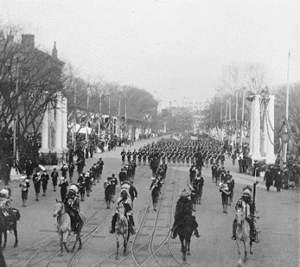In 1942, Sam Walton returned from serving his country as an officer in the U.S. Army Intelligence Corps during World War II. When he returned home, he needed to support his wife and child so he combined a loan of $20,000 from his father-in-law and $5,000 of his own money to start a business expansion of a small variety store in Newport, Arkansas. However, it wasn’t until 1962 that Walton opened the first Walmart store in Rogers, Arkansas. This first store led to the expansion of thousands of other locations around the globe.1
By 1967 Walmart had opened up 24 different stores that were rising to $12.7 million in sales. In 1969 the company officially incorporated as Walmart Stores, Inc.2 Walmart was doing so well that it quickly expanded into different countries, and it became an international business. Walmart now has 4,100 outlets in the United States and 3,100 in thirteen other countries around the world, including Asda in Britain. “Sales were over $374 billion last year (only slightly lower than the GDP of Denmark).”3 By 1976, Walmart became a publicly traded company with share values of more than $176 million. By the early 1990s, Walmart’s stock worth grew to $45 billion.4

When Walmart first began to expand, they set their sights on trying to eliminate their Kmart competition. It turned out to be a great strategic decision. At first, they only had small competition from regional discounters. In 1972 the competition had really just began. Kmart had a store in Hot Springs, Arkansas, which previously had no competition. Their prices and margins were so high that they almost weren’t even discounting their products. Walmart sent Phil Green to open up a store near that Kmart. This store would be known for its outrageous promotions like the large Tide display. The Tide display started because Green worked out a deal to get a dollar off a case if he bought 3,500 cases of a giant- sized box. One source describes, “it made up a pyramid of detergent boxes that ran twelve to eighteen cases high — all the way to the ceiling, and it was 75 or 100 feet long, which took up the whole aisle across the back of the store, and then it was about 12 feet wide so you could hardly get past it.”5 Green cut prices to the bone which led to Kmart losing many customers. This led to Walmart setting up a strategy to make its stores even better and more competitive.6
In 1976 a research group was set up with owners of regional retailers–who at the time didn’t compete in each other’s territories–had their first meeting in Bentonville. All of these sellers from throughout the region went through the Bentonville store to give feedback on what they saw to help the store make some adjustments. With all of the adjustments fixed and sorted out they “pulled [themselves] together and designed a big plan–a promotional program and a people program and a merchandising program.” Since their store in Hot Springs had turned out well they were very confident that they could compete now. This competition taught Kmart a little something about Walmart, and vice versa.7
Then in 1977 Kmart went head to head with Walmart in Little Rock. Kmart got aggressive, and Walmart didn’t back down. Walmart told the manager running that store, “No matter what, don’t let them undersell you at all, on anything.” Kmart got so aggressive that they cut the price on the Crest toothpaste to 6 cents a tube which led to Walmart doing the same thing. Walmart waited for Kmart’s response but nothing happened. Kmart had backed off. Walmart’s aggressiveness continually put pressure on their competitors, bringing Walmart success.8
When Walmart noticed that Kmart went after them in 1976 and 1977, they escalated expansion efforts by buying struggling discounters. In 1977 Walton’s brother Bud and David Glass negotiated a deal that bought a small chain Mohr Value in Illinois. They closed down five of the stores and then they transferred the remaining sixteen into new Walmarts in new territory. By 1979 Walmart had 230 stores opened, and the company hit their first billion dollars in sales.9
In 1983 Walton tried an experiment by opening the first Sam’s Club, a business designed to sell products in bulk to small business owners or people that like buying in bulk. For Sam’s Club, you needed to have a membership card to buy their bulk products. The people that opened up Sam’s Club can’t take credit for the idea of wholesale selling though, but Walton and his crew were the most successful at it.10

Competition could get spirited sometimes, and so Sam Walton went into one of the Price Clubs in San Diego with his tape recorder. He was going through the aisles, making notes about the prices and other merchandising ideas he saw while looking around. A tall guy noticed. He told Sam Walton, “I’m sorry but I’ll have to take your tape recorder and erase the material you’re got on it. We have a policy against people using them in the stores.”11 Walton knew he got caught, so he wanted to make a note to Robert Price that he had other information on the recorder from other stores that he would like back once he was done going through it. Walton got the tape back in about four days or so with all the information on it including the information on Price Club that he recorded.12
Sam Walton was always trying to improve his company, and in 1984, and he had a new bright idea. He switched Jack Shewmaker’s and David Glass’s jobs around so that Shewmaker became the Chief Financial Officer and the Vice-Chairman while Glass became President and Chief Operations Officer.This switch had everyone confused. Sam Walton never talked about why he switched their jobs around, and Shewmaker and Glass never said anything about it either. Surprisingly, after the switch, Walmart set new records. Everyone wondered whether Sam Walton was grooming a successor., which led to a lot of gossip going throughout the company.13
In 1982 Sam Walton developed a form of cancer — hairy cell leukemia. In November 1989 Walton got locked out of his house and climbed up the shoulders of the dog handler, crawling through a small window. The squeeze was a tight one and the dog whistle that was dangling from his neck got caught on the window, and it dig painfully into his sternum. The next day the pain got worse so he flew to see his physician in Houston. Little did he know that would lead to the discovery of another serious health problem, multiple myeloma. Sam Walton died on April 5, 1992.14

Everyone says that competition is a bad thing, but to Sam Walton, competition made his company better, thanks to all the information he gathered and all the changes he made along the way. Competition made him think outside the box to ensure the future of his company. In 2008 Walmart had 7,288 store worldwide and since then has continued to expand. Now, in 2018 Walmart has 11,718 stores worldwide.15 Walmart is doing so well that they have expanded the different services they provide. Walmart expanded to include Walmart neighborhood stores, which are popping up in different neighborhoods around the country. They also expanded their services to online ordering that you could pick up in the store and then later in one of their pick up lanes outside. Competition helped Saw Walton think outside the box which made Walmart very successful until today and beyond.16
- Biography.com, 2014, s.v. “Sam Walton Biography.” ↵
- “Timeline.” Our History, Walmart. https://corporate.walmart.com/our-story/our-history. ↵
- Edemariam Aida, “ It all began in a small store in Arkansas” The Guardian, 2009, https://www.theguardian.com/business/2009/mar/14/wal-mart-us-economy. ↵
- Biography.com, 2014, s.v. “Sam Walton Biography.” ↵
- Jordan Thaeler, “ Why Sam Walton Admits Retailer Inherently Unsophisticated” Medium, May 9, 2017. Accessed September 28, 2018. https://medium.com/@JJThaeler/why-sam-walton-admits-retailers-inherently-unsophisticated-b01a5ed7a9a. ↵
- Sam Walton and John Huey, Sam Walton: Made in America (New York: Doubleday, 1992), 191. ↵
- Sam Walton and John Huey, Sam Walton: Made in America (New York: Doubleday, 1992), 192-193. ↵
- Sam Walton and John Huey, Sam Walton: Made in America (New York: Doubleday, 1992), 193. ↵
- Sam Walton and John Huey, Sam Walton: Made in America (New York: Doubleday, 1992), 196. ↵
- Sam Walton and John Huey, Sam Walton: Made in America (New York: Doubleday, 1992), 199-200. ↵
- Sam Walton and John Huey, Sam Walton: Made in America (New York: Doubleday, 1992), 202. ↵
- Sam Walton and John Huey, Sam Walton: Made in America (New York: Doubleday, 1992), 202. ↵
- Vance H. Trimble, Sam Walton: The Inside story of America’s Richest Man (London; Penguin Group, 1990), 219. ↵
- Vance H. Trimble, Sam Walton: The inside story of America’s Richest Man (London; Penguin Group, 1990), 299-301; Biography.com, 2014, s.v. “Sam Walton Biography.” ↵
- “Total number of Walmart stores worldwide from 2008 to 2018,” Statista, March 2018, https://www.statista.com/statistics/256172/total-number-of-Walmart-stores-worldwide/. ↵
- “Business,” Walmart Today, blog.walmart.com/topics/business. ↵



82 comments
Thomas Fraire
This story is motivating since it demonstrates the development of an organization which currently gives fundamentally all that one needs over the world and to consider how Sam Walton swung $25,000 to what it transformed into what it is today is mind-boggling. The narrative of Walmart should fill in for instance to developing organizations around the globe. Incredible Article and pleasant pictures!
Eric Ortega Rodriguez
I have never heard of Sam Walton before. Now it makes sense why Walmart is associated with The Sam’s club. Walmart is a place many of us go to pick up essentials but we never actually look into how it came to be. I found it fascinating how Walton would outsell competitors and that he fought in World War II. Overall, this was a very informative and well-written article. Great work.
Leonardo Gallegos
This story is inspiring because it shows the growth of a company which now provides basically everything one needs across the world and to think of how Sam Walton turned $25,000 to what it turned into what it is today is incredible. The story of Walmart should serve as an example to growing businesses around the world. Great Article and nice pictures!
Michael Hinojosa
I’ve heard that there was a documentary about Walmart and it’s origin story and I was debating as to whether or not to watch it; but after reading this article I’m actually extremely interested in watching it just to see how the information there compares to the info here! It also certainly helps that for a long majority of my life my family and I went to Walmart for our shopping, so I guess it kind of has some type of childhood connection to me?
Noah Wesolowski
Walmart has always been that one company that I cannot see disappearing. When I drive by the stores are always full day and night but I never knew how the idea started. It fascinated me that it was made after world war 2 by a US army veteran. It amazes me how fast it caught on and how many store and how much money it started making in a few decades
Gabrien Gregory
This is such a well-written article. I did not know much about Walmart other than the fact Walton was a veteran who started Walmart. I think Walmart is perhaps the best example of our buying culture today. It may have started as a growing successful business, but today, it has also become part of a problem by using tactics to make people want to buy more and more. However, it is no doubt a success story.
Damian Jennings
I was aware that Sam Walton was the founder of Walmart and I do believe he has some connections to Sams Club, he was a hardworking man and look where it got him. Owning multiple stores across the nation and being recognized for his works. This was a nice and short article and I enjoyed the read!
Irene Astran
I appreciate the content that you bring to the table with this article. Throughout my time investigating the questionable measures of the Walmart franchise, I have not quite paid attention to the history of how it all began. I do wish your pictures were taken in better light or maybe edited before you placed them into your article. They do not quite measure up to the work you put into writing the article.
Eric Ortega Rodriguez
Wow, this article was fascinating. Especially since I have not heard much about Sam Walton. I would have never imagined that the creator a Walmart was also someone who fought in World War II. I also find it fascinating to what extents Walton would go through just to outsell the competition which demonstrates his drive and motivation to be the best at what he does. Overall, a very original topic selection and informative.
Alejandra Chavez
Who would have known that one of the starting key moves that Walmart ever made included a giant tower of laundry detergent. I also was astounded to read that they lowered their prices to 6 cents for a tube of toothpaste. I wish things were still like that. This is an amazing story of not backing down even in the face of intimidation. Wally world has undergone some big changes. This was a very well written article.